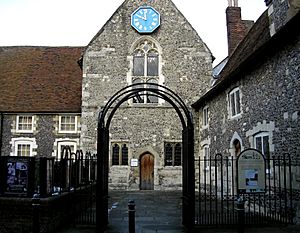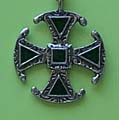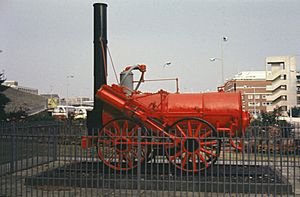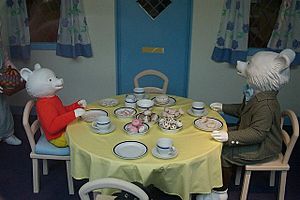Canterbury Heritage Museum facts for kids

Museum frontage
|
|
| Established | 1987 |
|---|---|
| Dissolved | 2018 |
| Location | Stour Street, Canterbury, Kent CT1 2NR |
| Type | Local history museum, Children's museum, Heritage museum |
| Public transit access | Rail: Canterbury West; Canterbury East Buses: National Express, Stagecoach |
The Canterbury Heritage Museum was a museum in Canterbury, England. It told the story of the city's past. The museum was located in a very old building called the Poor Priests' Hospital, which was built in the 12th century. This building is right next to the River Stour.
Inside the museum, you could see many interesting things. These included the famous Canterbury Cross and a special area dedicated to Rupert the Bear. Rupert's creator, Mary Tourtel, lived in Canterbury. The museum also hosted different events and exhibitions. It closed its doors in 2018. The building has since reopened as The Marlowe Kit, which is a place for escape rooms, exhibitions, and creative activities.
Contents
History of the Museum
How the Museum Started
The idea for the museum came from William Masters. He was a local plant expert who loved exotic plants. He helped start the museum and was its first honorary curator from 1823 to 1846.
The Poor Priests' Hospital Building
The museum was housed in a very old building from the medieval period. It was known as the Poor Priests' Hospital. This building, along with two others, sits right by the River Stour.
From 1174 to 1207, the main part of the building was a stone house. It belonged to a rich tanner and coin maker named Alexander. He later turned it into a special home for old and poor priests. This home was named after the Virgin Mary. The priests used the main room as a hall where they lived, ate, and slept around a central fire.
Later, in 1373, more rooms were added. These included a private living area for the head of the hospital. There was also a service area for servants, with a kitchen and storage rooms. A chapel, called the Chapel of St Mary, was also part of the building.
Over time, the building changed hands. After 1575, it was no longer used by priests. It became a school, a home for the poor, a place for work, and even a clinic. The museum officially opened in this historic building in 1987. It was set up to celebrate the history of Canterbury. The building was also carefully restored to show its original features, like the special roof.
Why the Museum Closed
The Canterbury Heritage Museum closed in 2018. This happened because fewer and fewer people were visiting. In five years, the number of visitors dropped from 30,000 to less than 9,000.
Many local groups, like the Canterbury Archaeological Trust, tried to keep it open. However, it still closed. On April 6, 2019, the building reopened with a new exhibition called The Marlowe Kit.
What Was Inside the Museum
Canterbury Heritage Museum Exhibits
The museum had many exhibits that showed Canterbury's history. These displays took you on a journey through time. You could learn about the city from pre-Roman times all the way to the present day.
There were sections on prehistoric times and the Anglo-Saxon period. You could explore a medieval discovery gallery. There was also a display about Christopher Marlowe and a special area about the wartime Blitz.
Other exhibits included a gallery about Joseph Conrad and displays featuring characters like Bagpuss and the Clangers. A popular part was the Rupert Bear Museum. The museum also had interactive displays. You could use a microscope, explore a treasure chest, and even pretend to spot planes from World War II. There was also a section with a Victorian collection, showing how people lived around 1900.
A large tapestry covered three walls, telling the life story of Thomas Becket. You could also see bones found in the area. These displays showed how experts could figure out what ancient people looked like.
A very special item in the Saxon gallery was the Canterbury Cross. This was an 850 AD Saxon brooch. It was found in St Georges Street in 1867. It looks like a special cross used to mark church walls.
The museum also displayed old furniture, household items, and weapons. Another important item was the Canterbury Pendant. This was a Saxon silver sundial that people could carry. It was made by St Dunstan around 909−988 AD. It was probably used to tell the time for prayers, especially at noon. This pendant was found in the Cathedral cloisters in 1938.
The famous Invicta locomotive was also kept here. Between 2009 and 2012, the museum also hosted many items from The Beaney museum. This was while The Beaney was being renovated. One of these items was a painting by Anthony van Dyck called Sir Basil Dixwell.
Rupert Bear Museum
The Rupert Bear Museum opened in 2003. It received a lot of money from the Heritage Lottery Fund to help set it up. Mary Tourtel, who created Rupert Bear, grew up and went to art school in Canterbury. The museum had a very first edition of a Rupert annual book from 1921.
The Rupert Bear Museum offered fun activities for children. These activities focused on playing, having fun, and learning. It also had a special display for Bagpuss and the Clangers. This included items from the original TV shows. For example, you could see Emily's shop window from the start of Bagpuss. This is because the creators, Peter Firmin and Oliver Postgate, filmed the shows near Canterbury.
Events and Accessibility
The museum often held interactive events for families. For example, in June 2008, there was a two-day celebration for Ian Fleming's 100th birthday. He created the James Bond films. In November 2008, there was a Rupert Bear Day. The new Rupert Bear illustrator, Stuart Trotter, signed books there.
In July 2009, the museum celebrated the anniversary of Neil Armstrong's first moonwalk in 1969. This was an interactive event where people could talk to astronomers. There was also an astrodome that showed a 3D tour of the night sky and Solar System. In 2009, the museum also celebrated the 40th anniversary of The Clangers TV show. They had two interactive events, including meetings with Peter Firmin, one of the show's creators. Oliver Postgate, the other creator of Bagpuss and the Clangers, lived nearby and had given his creations to the museum before he passed away in 2008.
The museum was open during certain times of the year, usually from March to September. It was also open during school holidays. The museum had access for people with disabilities. There was an entrance fee to visit.




